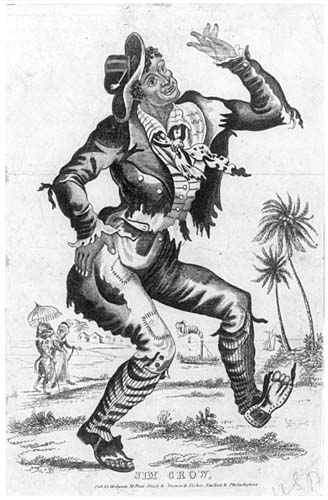Title
Old Jaw Bone, The
Type
Song
Description
[Alternately: “De Ole Jaw Bone,” “Old Jaw Bone”]
To listen to this song (and others) on the Artists Respond to Juba Site, Click Here.
According to Nathan, like “Possum Up a Gum Tree,” the song comes from an African American canon and can be traced back to African American banjoists performing in Tennessee during the 1830s (186). Lyrics for the version surveyed for this entry appear to combine a number of disparate elements. On the one hand, the title of the song refers to an early variant of the bones – a defining instrument in the minstrel ensemble – that was literally taken from a slaughtered horse, ox, ass or sheep (Nathan 149). On the other hand, Mahar records that lyrics were inspired by two British ballads from the early nineteenth century, both by Thomas Haynes Bayley (1797-1839): “Young Bowshin’s Bride. A Pathetic Ballad,” and “The Mistletoe Bough” (257; 320). In both songs, a young female falls upon misfortune when she decides to break from festive dancing in order to engage in a game of hide-and-seek. The young girl is trapped in her hiding place and perishes there, only to be discovered years later. According to Mahar, there is another version of the song published in 1840 at Boston that parodies Michael Rolphino Lacy’s (1795-1867) Cinderella; or, The Fairy and the Little Glass Slipper (itself an adaptation of Rossini’s La Cenerentola) (408; footnote 84).
Given the source material, it is unclear why the song is thus titled, or, for that matter, why the jaw bone is the subject of the chorus. In the version surveyed for this entry, the jaw bone is referred to in the first verse as the coat-rack upon which visitors hang their jackets. Given the number of songs that make reference to the jaw bone, and its presence in the ensemble, it seems that the image was a common trope in the tradition. The current status of the song is uncertain, and, as of the time of the writing of this entry, there do not appear to be any recorded versions of this particular version.
Works Cited:Mahar, William J. Behind the Burnt Cork Mask: Early Blackface Minstrelsy and Antebellum American Popular Culture. Chicago: Illinois UP, 1999.
Nathan, Hans. Dan Emmett and the Rise of Early Negro Minstrelsy. Norman: Oklahoma UP, 1962.
To listen to this song (and others) on the Artists Respond to Juba Site, Click Here.
According to Nathan, like “Possum Up a Gum Tree,” the song comes from an African American canon and can be traced back to African American banjoists performing in Tennessee during the 1830s (186). Lyrics for the version surveyed for this entry appear to combine a number of disparate elements. On the one hand, the title of the song refers to an early variant of the bones – a defining instrument in the minstrel ensemble – that was literally taken from a slaughtered horse, ox, ass or sheep (Nathan 149). On the other hand, Mahar records that lyrics were inspired by two British ballads from the early nineteenth century, both by Thomas Haynes Bayley (1797-1839): “Young Bowshin’s Bride. A Pathetic Ballad,” and “The Mistletoe Bough” (257; 320). In both songs, a young female falls upon misfortune when she decides to break from festive dancing in order to engage in a game of hide-and-seek. The young girl is trapped in her hiding place and perishes there, only to be discovered years later. According to Mahar, there is another version of the song published in 1840 at Boston that parodies Michael Rolphino Lacy’s (1795-1867) Cinderella; or, The Fairy and the Little Glass Slipper (itself an adaptation of Rossini’s La Cenerentola) (408; footnote 84).
Given the source material, it is unclear why the song is thus titled, or, for that matter, why the jaw bone is the subject of the chorus. In the version surveyed for this entry, the jaw bone is referred to in the first verse as the coat-rack upon which visitors hang their jackets. Given the number of songs that make reference to the jaw bone, and its presence in the ensemble, it seems that the image was a common trope in the tradition. The current status of the song is uncertain, and, as of the time of the writing of this entry, there do not appear to be any recorded versions of this particular version.
Works Cited:
Mark Turner
Performance(s) listed of this act
| Performer(s) | Troupe | Event and Venue |
|---|---|---|
| Harrington, George | Minstrel Show,
-
St. James Theatre, London (city-county) |
|
| Ethiopian Serenaders (1846-48) | Minstrel Show,
-
St. James Theatre, London (city-county) |
|
| Ludlow, M.C. | Variety,
-
Vauxhall Gardens, London (city-county) |
|
| Ethiopian Serenaders (1848-49) | Variety,
-
Vauxhall Gardens, London (city-county) |
|
| Harrington, George | Minstrel Show,
-
St. James Theatre, London (city-county) |
|
| Ethiopian Serenaders (1846-48) | Minstrel Show,
-
St. James Theatre, London (city-county) |
|
| Minstrel Show,
-
St. James Theatre, London (city-county) |
||
| Ethiopian Serenaders (1846-48) | Minstrel Show,
-
St. James Theatre, London (city-county) |
|
| Minstrel Show,
-
St. James Theatre, London (city-county) |
||
| Minstrel Show,
-
St. James Theatre, London (city-county) |
||
| Ludlow, M.C. | Minstrel Show,
-
, Devon |
|
| Ethiopian Serenaders (1850) | Minstrel Show,
-
, Devon |

